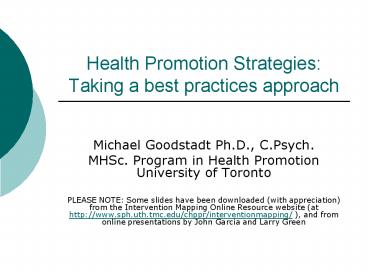Health Promotion Strategies: Taking a best practices approach - PowerPoint PPT Presentation
1 / 21
Title:
Health Promotion Strategies: Taking a best practices approach
Description:
... have been used to create effective interventions not to create a new process ... Select theory-based intervention methods and practical strategies ... – PowerPoint PPT presentation
Number of Views:1930
Avg rating:3.0/5.0
Title: Health Promotion Strategies: Taking a best practices approach
1
Health Promotion StrategiesTaking a best
practices approach
- Michael Goodstadt Ph.D., C.Psych.
- MHSc. Program in Health Promotion University of
Toronto - PLEASE NOTE Some slides have been downloaded
(with appreciation) from the Intervention Mapping
Online Resource website (at http//www.sph.uth.tmc
.edu/chppr/interventionmapping/ ), and from
online presentations by John Garcia and Larry
Green
2
Introduction to HP Strategies course
- Personal introductions
- House keeping registration etc.
- Introduction to course (walk through course
outline) - Perspectives
- Students
- Mine
- Diversity
- Next weeks assignments
- Introduction to the Intervention Mapping Approach
3
How do we make the best decisions possible in
planning, implementing evaluating health
promotion practice?
- The Intervention Mapping Approach Setting the
stage(Bartholomew et al., 2006)
4
Intervention Mapping Approach
- Intervention Mapping Approach development was
stimulated by questions to which couldnt find
answers from health education health promotion
resources re - Theory
- Evidence
- Effectiveness
- Taking an ecological approach
- However, goal was to describe clarify the
processes that have been used to create effective
interventionsnot to create a new process
5
Intervention mapping guiding frameworks
- Iterative planning, implementation and evaluation
cycle involving six steps (Figure 1.2) - Socio-ecological (interactive) approach (Figure
1.1) six levels - Six core processes in planning and implementation
(Figure 2.1)
6
Six steps of the Intervention Mapping Approach
- Conduct a needs assessment
- Create matrices of change objectives based on the
determinants of behavior and environmental
conditions - Select theory-based intervention methods and
practical strategies - Translate methods and strategies into an
organized program - Plan for adoption, implementation and
sustainability of the program - Generate an evaluation plan
7
Intervention Mapping six steps (Figure 1.2)
8
Six interacting levels of the ecological approach
(Figure 1.1)
- Individual
- Interpersonal
- Organizational
- Community
- Societal
- Supranational
9
(No Transcript)
10
Six core processes (Figure 2.1)
- Pose the question
- Brainstorm a provisional list of answers
- Review the literature related to the topic at
hand(Some of the findings will be strictly
empirical others will be based on theory)
- Review the literature for theory using the
concept and general theories approaches - Assess and address needs for new research
- Formulate a working list of answers to the posed
question
11
Intervention Mapping Approach Logic models
- PRECEDE-PROCEED (Green Kreuter, 2005)
- Logic model of risk (Figure 1.2)
- Intervention logic model (Figures 1.4 10.1)
12
Surveillance, Planning and Evaluating for Policy
and Action PRECEDE-PROCEED MODEL
Formative evaluation baselines for outcome
evaluation
Intervention Mapping Tailoring
Phase 6 Implementation
Phase 7 Process evaluation
Phase 8 Impact evaluation
Phase 9 Outcome evaluation
Monitoring Continuous Quality Improvement
Output
Longer-term health outcome
Short-term social impact
Short-term impact
Process
Input
Long-term social impact
New in 4th ed., Green Kreuter, Health
Promotion Planning, in press.
13
Planning the needs assessment with a logic model
adapted from Green Kreuters PRECEDE-PROCEED
MODEL (see Glanz et al., 2008, chapter 18)
Phase 4
Phase 3
Phase 2
Phase 1
Personal and External Determinants (Predisposing,
enabling and reinforcing factors)
Qualityof LifeIndicators
BehavioralFactors
HealthProblems
Personal and External Determinants (Predisposing,
enabling and reinforcing factors)
EnvironmentalFactors
14
Logic Model of Risk(Bartholomew et al. 2006,
p.26)
Personal Determinants
Behaviourof at-risk groups
External Determinants
HealthProblems
Qualityof Life
EnvironmentalFactors (including behavior of
environmental agents
Personal Determinants
External Determinants
15
What needs to change?
Phase 4
Phase 3
Phase 2
Phase 1
Qualityof LifeIndicators
BehavioralFactors
HealthProblems
Determinants
Determinants
EnvironmentalFactors
Societal
Community
Organizational
Interpersonal
16
Logic Model of Change
At Risk Group
Quality of Life
Behavioral Outcomes
Performance Objectives
Determinants
Change Objectives
Health
Environmental Outcomes
Performance Objectives
Change Objectives
Determinants
Environmental Agent
Logic of Change
Outcomes
Step 2
Step 1
17
Methods at the individual level
Personal determinants of adolescent smoking
Methods at the organizational level
Adolescent smoking behavior
Personal determinants of school board
Methods at the societal level
School Board implements ban on smoking
Personal determinants of legislature
Government State or national non-smoking policy
Shifting Levels of Intervention
18
(No Transcript)
19
(No Transcript)
20
(No Transcript)
21
(No Transcript)































